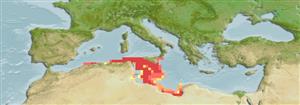Elasmobranchii (Haie und Rochen) (sharks and rays) >
Rajiformes (Skates and rays) >
Rajidae (Skates)
Etymology: Leucoraja: Greek, leykos = white + Latin, raja = a fish, Raja sp. (Ref. 45335).
Environment: milieu / climate zone / depth range / distribution range
Ökologie
seewasser bathydemersal; tiefenbereich 60 - 800 m (Ref. 106604). Deep-water; 42°N - 36°N, 2°W - 16°E
Mediterranean Sea: endemic to the coasts of Tunisia, Malta and a single record from Italy; rare off Algeria.
Size / Gewicht / Alter
Maturity: Lm ? range ? - ? cm
Max length : 52.0 cm TL Männchen/unbestimmt; (Ref. 125195); 45.0 cm TL (female)
Feed on crustaceans mainly amphipods (Ref. 3167). Oviparous. Distinct pairing with embrace. Young may tend to follow large objects, such as their mother (Ref. 205). Eggs are oblong capsules with stiff pointed horns at the corners deposited in sandy or muddy flats (Ref. 205). About 10-56 eggs are laid per individual annually (Ref. 41305, 41314).
Oviparous, paired eggs are laid. Embryos feed solely on yolk (Ref. 50449). Breeds throughout the year, but ripe females observed mainly in spring and autumn (Ref. 3167). Distinct pairing with embrace. Young may tend to follow large objects, such as their mother (Ref. 205).
McEachran, J.D. and K.A. Dunn, 1998. Phylogenetic analysis of skates, a morphologically conservative clade of elasmobranchs (Chondrichthyes: Rajidae). Copeia 1998(2):271-290. (Ref. 27314)
IUCN Rote Liste Status (Ref. 130435)
Bedrohung für Menschen
Harmless
Nutzung durch Menschen
Mehr Information
Alter/GrößeWachstumLänge-GewichtLänge-LängeLängenhäufigkeitenMorphometrieMorphologieLarvenLarven Pop.Dyn.RekrutierungDichteBRUVS
ReferenzenAquakulturAquakultur ProfilZuchtlinienGenetikElectrophoresesVererbbarkeitKrankheitenVerarbeitungNutrientsMass conversion
Tools
Zusatzinformationen
Download XML
Internet Quellen
Estimates based on models
Preferred temperature (Ref.
123201): 13.1 - 14.6, mean 14 °C (based on 23 cells).
Phylogenetic diversity index (Ref.
82804): PD
50 = 0.5000 [Uniqueness, from 0.5 = low to 2.0 = high].
Bayesian length-weight: a=0.00229 (0.00141 - 0.00373), b=3.21 (3.07 - 3.35), in cm total length, based on LWR estimates for this species & Genus-body shape (Ref.
93245).
Trophic level (Ref.
69278): 3.3 ±0.53 se; based on food items.
Widerstandsfähigkeit (Ref.
120179): niedrig, Verdopplung der Population dauert 4,5 - 14 Jahre. (Fec=10).
Fishing Vulnerability (Ref.
59153): Moderate vulnerability (41 of 100).
Nutrients (Ref.
124155): Calcium = 6.32 [0.98, 122.77] mg/100g; Iron = 0.346 [0.033, 4.702] mg/100g; Protein = 15.1 [13.0, 17.2] %; Omega3 = 0.455 [0.180, 1.150] g/100g; Selenium = 14.5 [2.5, 68.7] μg/100g; VitaminA = 5.07 [0.37, 64.27] μg/100g; Zinc = 0.329 [0.023, 3.815] mg/100g (wet weight);
